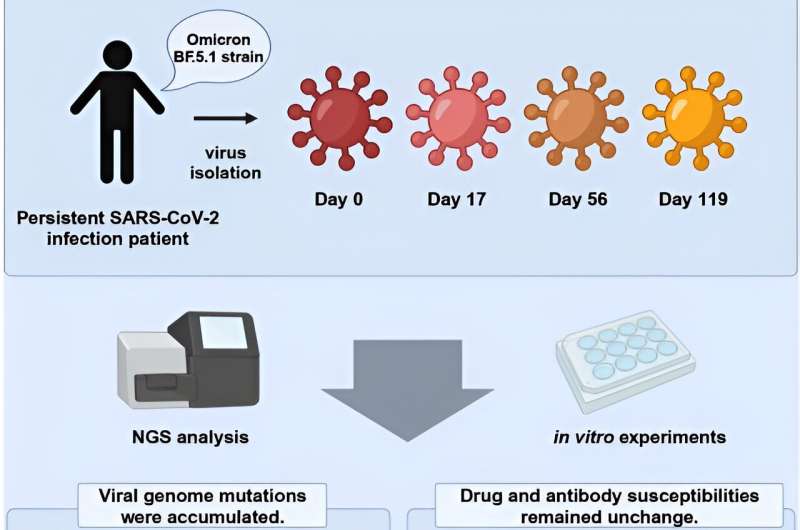This article has been reviewed according to Science X's editorial process and policies. Editors have highlighted the following attributes while ensuring the content's credibility:
fact-checked
peer-reviewed publication
trusted source
proofread
Researchers predict real-world SARS-CoV-2 evolution by monitoring mutations of viral isolates

Junior Associate Professor Kazuo Takayama (Department of Cell Growth and Differentiation) and a collaborative team of researchers in Japan recently characterized SARS-CoV-2 collected from a persistent COVID-19 patient to identify critical factors responsible for generating new mutant strains.
The COVID-19 pandemic, caused by the SARS-CoV-2, was in part due to rapid viral evolution that continuously generated new variants. While multiple factors are known to contribute to the rapid emergence of mutant strains, the principal contributing factors remain unclear.
In this study, accepted for publication in iScience, the researchers collected serum samples and viral isolates from an immunocompromised patient who was persistently infected by the SARS-CoV-2 omicron variant BF.5 over several months to track its evolution and potentially identify crucial factors responsible for the widespread effects of this respiratory virus.
Due to the patient's chronic immunosuppression as part of the treatment for eosinophilic fasciitis, the researchers detected only low antibody levels against SARS-CoV-2 in the samples. Conversely, although they detected cytolytic granules in the sera collected from the patient, suggesting that NK (natural killer) and CD8+ T cells were likely functional, the research team concluded that these immune cells alone, without sufficient antibody production by B cells, were incapable of successfully eliminating the virus from the patient.
The researchers next analyzed the viral genomes isolated from the swab samples by next-generation sequencing methods. Remarkably, whereas the viral genome mutated at 10 locations between the first and two sampling time points (days 0 and 17), it changed at 27 and 37 locations, respectively, during the second and third intervals between sample collection (days 18–56 and 57–119), suggesting the virus could acquire mutations quicker when left unchecked for more than two months.
Utilizing their expertise in organoid technology, the researchers examined the viruses' replicative capacity and their effects on host cells by infecting human iPS cell-derived lung organoids with each viral isolate. They detected similar viral gene expression and production levels across isolates, demonstrating that infectivity was generally unaltered during the entire course of a persistent SARS-CoV-2 infection.
In addition, the researchers examined the sensitivity to the antiviral drug, remdesivir, and anti-spike protein antibody therapy, sotrovimab, using lung organoids. All viral isolates showed high susceptibility to remdesivir treatment but were largely resistant to the antibody therapy, as they all contained spike protein mutations (G339D or R346T) known to render them resistant to sotrovimab. These findings indicate that infectivity and sensitivity to antiviral treatments remained mostly unchanged despite acquiring multiple mutations during the persistent infection.
To determine whether studying the viral isolates from a patient suffering from persistent SARS-CoV-2 infection can help predict viral evolution, the researchers focused on the S protein amino acid sequence and performed comparative phylogenetic analysis with emergent SARS-CoV-2 strains arising in the real world.
Notably, several mutations (D574N, S975N, S1003I, and A1174V), relatively rare before the appearance of BF.5, were acquired during persistent infection, indicating that they may be more likely to emerge from the BF.5 strain. The research team thus tested this idea by examining the frequency of these mutations in strains appearing after the BF.5 strain.
Remarkably, the D574N and S1003I mutations were detected in greater than 1% of descendant strains emerging from BA.5 (BA.5.24, BA.5.2.36, CG.1, BF.7.26, and BQ.1.1.21), thus demonstrating the potential and real-world implication of analyzing viral evolution in persistently infected patients.
In summary, the study illustrates the potential of studying how viruses change over time in patients with persistent infections as a parallel to predict how they may evolve in the real world. However, it is crucial to note that additional persistently infected patients must be included to determine the general applicability of such findings because individual differences could potentially skew viral evolution.
More information: Hiroki Futatsusako et al, Longitudinal analysis of genomic mutations in SARS-CoV-2 isolates from persistent COVID-19 patient, iScience (2024). DOI: 10.1016/j.isci.2024.109597





















